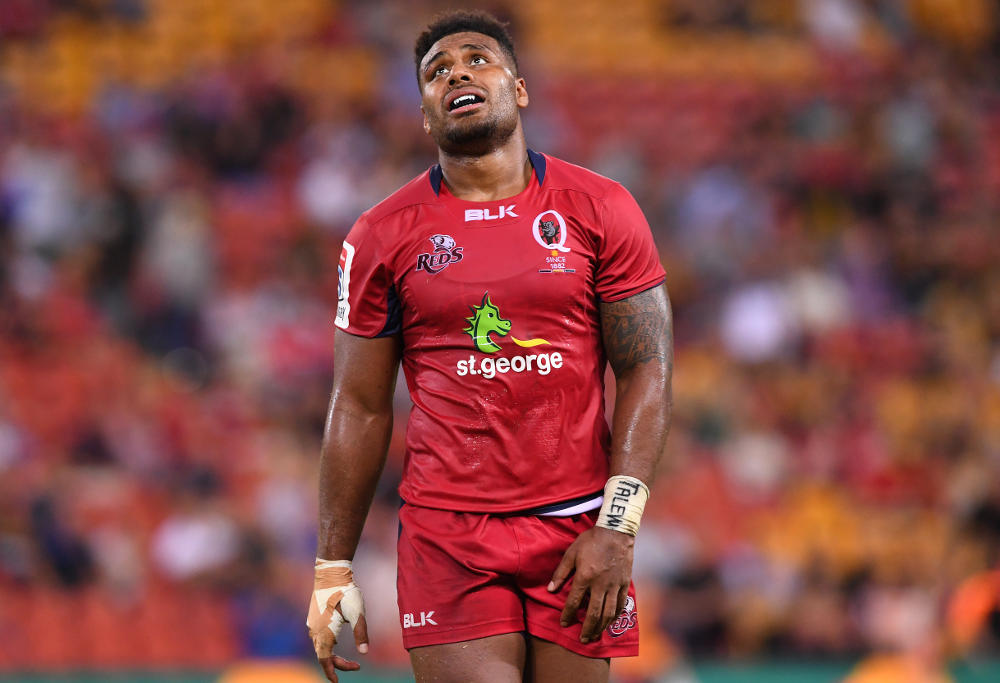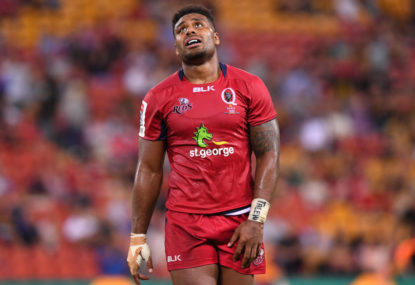With the Waratahs yesterday completing a clean sweep of four Australian franchise defeats to New Zealand sides over the weekend, voices calling for a cut to Australia’s involvement in Super rugby are likely to grow even louder.
If the Waratahs made a mistake, aside from not finding ways to get ball to their Scottish import Taqele Naiyarovoro, it was to take the Crusaders on at a broken, unstructured game, full of long passages of play. Waratahs fans should be happy with the effort shown, but this type of rugby is meat and drink to the Crusaders; better conditioned, more skilled and high on the confidence that six straight wins brings.
There was an odd symmetry to Aaron Smith’s milestone 100th Super Rugby game falling on the same day we learnt about Florida man Matthew Notebaert being jailed for five years for killing his wife Amanda, engaged in sex with her while driving his car at 90km/h in a 50km/h zone, through a heavily signposted dead-end and air into a concrete-walled canal.
Everything has its right time and place.
Smith this time found himself in the right place at the right time, expertly steering the Highlanders around Forsyth Barr Stadium, to a 51-12 win over a poor Melbourne Rebels.
More than any side, the Rebels have struck bad luck with injury this season and, once again, they lost lock Steve Cummins in the first minute. But a closer look shows that Cummins’ head knock wasn’t bad luck at all, but rather poor technique in what should have been a simple, regulation tackle, just the first in a long series of Rebels players showing little regard for the basics of the game.

If the Rebels weren’t dropping good passes or firing bad ones, or unable to execute their set piece, Jordy Reid and James Hanson found a new way to turn the ball over, inattentively standing on the touchline. Dispiriting.
By contrast, the Force were far keener and better organised, and fully deserved the opening try to Richie Arnold. What odds his middle name is Potsie?
In the end, it was ‘happy days’ for the Blues, on the scoreboard at least, 24-15, although they won’t want to continue conceding slow starts. They got good impact off the bench, particularly from Akira Ioane, and Ihaia West again provided a spark that Piers Francis doesn’t have at flyhalf.
The Force is a vastly improved side on previous versions, as much in intent and watchability as anything. Dane Haylett-Petty had his best game of the season, and what a great sight lock Matt Philip was, still running his lungs out in the 78th minute. A little more self-belief and they appear to be on a path to seriously compete for the Australian conference.
Providing, of course, they are allowed to stay in the competition.
A word too for Japanese referee, Shuhei Kubo; calm, assured and accurate. Everything a referee should be.
It was another milestone match in Hamilton, this time World Cup water-boy Liam Messam in his 150th Super Rugby match. The Bulls showed him scant respect, starting hot and keeping up the energy and positive intent, Burger Odendaal leading the charge with purposeful, direct running. It took some individual magic from Shaun Stevenson to finally edge the Chiefs ahead, with a superb in and out, then kick and chase.
Maybe the Chiefs, coming off a bye and a stuttering performance in Melbourne, are still a little off, but full credit to the Bulls for setting the tone of the game, despite the 12-28 final score. They are a better side than their one win so far suggests.
Special mention to Brodie Retallick, going out in sympathy with Reid and Hanson, inadvertently stepping on the chalk when in possession. And what exactly was Jonathan Faauli doing forgetting he had arms and letting the ball hit him in the head?
Remarkably good conditions in Brisbane provided a rollicking, entertaining contest to which both sides contributed equally. After threatening a blowout early, the Hurricanes will be secretly delighted they were required to answer an impressive second quarter comeback by the Reds, before eventually securing a bonus point win, 34-15.

Scott Higginbotham’s try was one to savour – his behind the back pass so audacious it deserved not to be checked – but after a trip back from Buenos Aries, and because the ‘Canes are the ‘Canes, the Reds were never going to match them in a shoot-out over the whole 80 minutes.
Whatever the state of Australian rugby, and the abject record against New Zealand sides, any fan who left Suncorp Stadium on Saturday night dissatisfied with the rugby on display – regardless of who they support – is surely a hard person to please.
This was a night to forget about SANZAAR’s woes and sit back and watch class players express themselves; the Barrett brothers, Ardie Savea, TJ Perenara, Samu Kerevi and George Smith among the best.
TMO Damien Mitchelmore had a busy night frustrating the Hurricanes on numerous occasions, although, it must be said, mostly getting the calls right. There was a nice moment after Perenara scored what he thought was his second try, taking off so quickly from a penalty it looked like he hadn’t even tapped it. Which, as Mitchelmore discovered, he hadn’t.
There will be people who have watched rugby all their life who have never seen a referee change their decision due to a player arguing a point of law. Full credit to Angus Gardiner for manning up and doing so, after Perenara had the presence of mind to correctly question his decision to re-start with a scrum.
The Stormers enjoyed their return to Newlands, continuing in their 2017 attacking style, putting 50 points on the powerless Cheetahs. Impressive stuff.
There’s something special about a barrel-chested prop hurtling 25m up the centre of the field, Coenie Oosthuizen opening the scoring with a ripping try. With 19-year-old Curwin Bosch popping over long-range penalties and a 45m drop goal seemingly for fun, the Lions were put under the kind of intense heat their high energy game usually applies to others.
The turning point came when Sharks lock Etienne Oosthuizen twice caught the eye of TMO Johan Greef, resulting in a Sharks try being ruled out and two tries to the Lions while he was in the bin. As far asz ‘neck rolls’ are concerned, both were at the lower end of the scale, but the lesson is not to go there in the first place.
With this thrilling match in the balance, Bosch coolly jammed another penalty home from well over 60m on the angle and South Africa looks to have a real talent in the making. Another special player, sevens star Kwagga Smith, expertly sent Jaco Kriel away for the winner, 34-29 and top spot in what is a red-hot Africa 2 conference.
This match encapsulates Super Rugby’s woes in one neat package. Fast-paced, physical rugby played with great intent from both sides, the result in the balance right until the final whistle, in front of over 40,000 fans who were loving every minute of it.
For years now, Super Rugby has consistently delivered, and continues to deliver, rugby of high quality and high drama. Right now, if the Hurricanes and Lions were Test sides, they would reside high up the international pecking order.

If there is the occasional sneer from the north about deficient defensive patterns, so be it. Devotees are prepared to trade this off for the emphasis on ball movement, expression of individual skill and playing at pace.
Yet Australian rugby fans are left believing that rugby’s sky has fallen in, or at least they are being told daily that it is about to. Doom and gloom reigns supreme.
The problem is most Australian fans don’t love rugby enough to care about the Lions or the Sharks, or the Jaguares or Sunwolves either; no matter the quality of this contest, or, for example, the often superb back play of the Sunwolves.
It is obvious from much of the criticism in these pages that many posters have never actually seen these teams play.
So whatever path SANZAAR chooses from here, the real issue isn’t about whether or not 15 or 18 teams is the right number. Instead, they must solve some fundamental problems:
– Their catchment covers over half the world, inducing severe challenges with travel and time zones for viewing
– Disjointed scheduling doesn’t allow sides to play regular home games, cutting into memberships and building of core support bases
– Their revenue source ties them to pay TV, meaning that, in Australia particularly, much of the competition takes place in the ether, between teams that fans and potential fans have no engagement with
– Fans strongly dislike the current conference structure and the way finalists are determined
I fear any impending announcement will address the final point only, whereas SANZAAR should actually focus on working around their constraints to do a much better job at marketing their strengths (the quality of the rugby and the skill of their star players) so rugby fans everywhere are provided with a heightened sense of excitement, belonging and engagement with Super Rugby.
As for Australia dropping yet another four matches against New Zealand franchises? That’s a source of despair right now, but not a fundamental Super Rugby problem. Good rugby people shifting the focus from petty domestic squabbles to checking their egos and contributing positively in behind the central administering body to help improve coaching standards and player depth would turn this around quickly enough.
They are two separate matters; SANZAAR needs to fix the structure of Super Rugby and connect it to a wider potential fan-base, and Australian administrators, coaches and players simply need to get better.
The notion that fixing the first problem will automatically fix the second is flawed in the extreme.
































































































